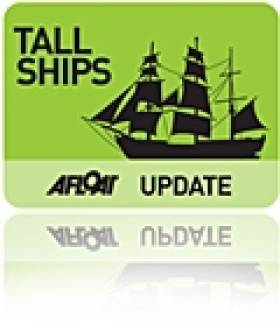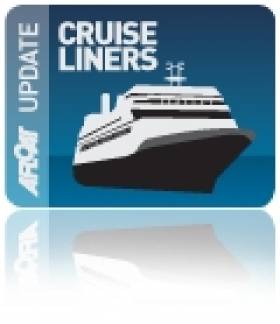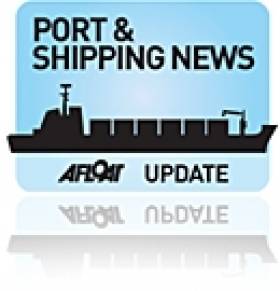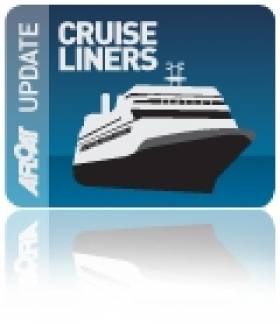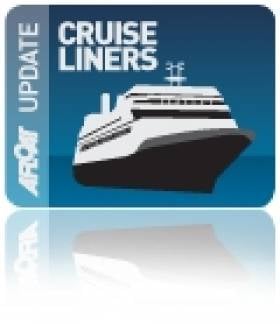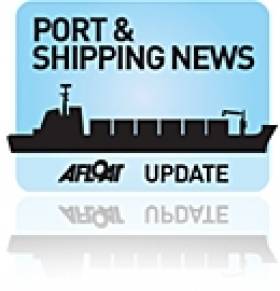Displaying items by tag: Dublin Port news
The Future’s Green, Bright and Orange
This month ASN are due delivery of the 4,700 gross tonnes Arklow Bridge, the second 'B' class newbuild was also built by the Dutch company of Bodewes Shipyards B.V. She is the fifth vessel to carry this name since Arklow Shipping was founded in 1966.
The Arklow Bridge is registered in St. John's the capital of the Caribbean island of Antigua where she will be flagged. Antigua became an associated state of the Commonwealth until it was disassociated from Britain 30 years ago.
Her sister Arklow Brook entered service this year and is designed with two holds with a total (grain and bale) capacity of 9473.1m3 or an equivalent of 33,4524 ft3.
For cargo-separation the holds can be sub-divided by a portable bulkhead in up to 8 positions. In addition to carrying agricultural-based cargoes, the 116m (OA) overall long vessel can handle 177 (TEU) containers in the hold and another 88 can be stowed on top of the hold's hatch covers. Both the holds are fitted with dehumidifier's.
The power-plant is derived from a MaK 6M32C 2999kW main engine with a Renk gearbox and Berg controllable pitch propeller that provides around 12 knots.
With the entry of Arklow Bridge, the combined fleet is over 40 ships that trade in the north-west of Europe and the Mediterranean. For further vessel statistics of the sisters click here and for a photo of the new vessel click this link.
Asides the Rotterdam based operation of ASN, the Irish side of the company is the largest indigenous owned shipping company in terms of Irish-flagged and registered tonnage. Arklow is not only the headquarter's of ASL but the homeport is also where the vessels are registered.
- Dublin Port
- Co. Wicklow
- Arklow Shipping
- Newbuilds
- The Netherlands
- Arklow Shipping Ltd
- Ports and Shipping News
- Caribbean
- DryDock
- Antigua
- British
- Dublin Port news
- Arklow Bridge
- Arklow Brook
- ASN
- Arklow Shipping B.V.
- Irishflagged
- Irishregistered
- Arklow Future
- Bodewes Shipyards
- Dutchflagged
- Antiguaflagged
- Mak
- The Commonwealth
- River Avoca
Antigua On All-Island Visit
Antigua was originally a fishing boat built in 1957 at Thorne, Yorkshire but her appearance is completely different today. Gone are the fish as the vessel spent four years undergoing reconstruction for the purposes of accommodating paying-passengers. The work was completed in 1997 and this has included the provision of sixteen double cabins in luxurious surroundings.
Individual booking cruises can be made on the brigantine and her fleet-mates which are owned by the Tall Ships Company which take passengers on destinations not just in European waters but also to the Arctic.
The company also operate another brigantine the Artemis, the barque Artemis, the schooner Mare Frisium and the clipper Elizabeth. For further information about the company click here.
A Former Royal is Set to Return
At 6,000 tonnes, the luxuriously appointed expedition cruiseship caters for only 132 guests. She is designed to explore remote waters and with an ice-strenghtened hull she can provide destinations that include the polar ice-caps. Shore-based excursions from the ship are taken by a fleet of Zodiac-craft to transport passengers to isolated locations.
Onboard the Bahama-flagged vessel, passenger can browse in the boutique, sip a drink in the internet café, enjoy a full-service spa, take a beauty treatment in the salon, get fit in the gym or take it easy in the sauna. Plus there's live-evening entertainment and not forgetting the two top-deck whirlpools.
For a vessel of this size her facilities are comparatively impressive to the large cruise giant's such as the Grand Princess. She became the first cruiseship to measure over 100,000 tonnes when she made an inaugural call to the capital in 2004.
Nearly 300m long the vessel is the equivalent in length to three football pitches. The ship may not actually feature a playing pitch though she does have a nine-hole putting golf course!
A floating crane-barge with a 1,000 ton lifting capacity hoisted the structure sky-high away from the ship which was berthed at the Grand Bahama Shipyard drydock facility. The ships owners, Princess Cruises cited the main reason for the removal was in order to 'significantly improve the operational performance of the ship, including greater fuel efficiency.'
Grand Princess may have lost her signature Skywalker Nightckub but three-decks below a new nightclub, One5, inspired by its Deck 15 location was created. In addition to this work which took place during April and May the 2,600 passenger cruisehip also underwent a major refit. The ship which had its last major refurbishment in 2004 has amenities to include an outdoor movie screen, fitness centre, spa, casino and four swimming pools.
For 'interactive' deckplans click here and interior slideshow click this link.
The distinctive 'Skywalker' feature became one of the most iconic in cruiseship naval architecture when the Grand Princess was launched as leadship
of the 'Grand' class in 1998. Located at the extreme aft of the vessel, the nightclub could only be reached by clubbers using an angled walkway (photo). Externally the feature was referred by some as the 'shopping trolley' and others percieved the design infleunce from towering poops found on ancient war-faring galleons.
Irrespective of the design origins, another 10 'Grand' class vessels were built by the Italian Fincantieni (at Malfalcone) Shipbuilding Group. The 'handle' (photo) feature on the Grand Princess was made with a heavier material compared to Golden Princess (2001) and Star Princess completed a year later. So there are no plans to remove these nightclubs. Of the more recent additions to the class modifications have appeared, notably without the inclusion of the Skywalker Nightclub's but there are changes to funnel designs.
Outside the Princess Cruises brand, the Ventura and Azura (also of the Grand-class) operate for P&O Cruises, serving the UK market from Southampton. The Hamsphire port welcomed the pioneering leadship Grand Princess on 5 May after she made a 16-day trans-Atlantic repositioning voyage from Port Everglades.
The cruiseship which has a crew of 1,200 alone will make the UK port its seasonal homeport this year from where she sails on cruises in Europe. On one of these cruises itineraries the Grand Princess (290m long x 36 beam X 8.5m draft) included a visit to the Port of Cork today. You can monitor the ship from Cobh Cruise Terminal via the 'live' bridge web-cam, noting the vessel is due to depart at 18.00 this evening bound for Dublin Port.
Grand Princess became the first cruiseship to measure over 100,000 gross registered tonnes when the 108,806 (grt) vessel docked in Dublin on 31 August 2004.
Last year the port handled 88 cruisecalls and this number of vessels is to be closely repeated this season. Over 200 cruise calls with around half a million passengers and crew are scheduled to visit the island of Ireland. The cruise sector business is estimated to generate €60m to the economies
north and south.
Varadkar Warns of No Bail-Out to State-Owned Ports
In the report it was noted that there are too many ports and that the sector would benefit from a rationalisation of ownership and management structures. The decision which will be made over the next few months not only concerns the fate of the capital port but also the following state-owned ports: Dun Laoghaire, Waterford, Drogheda, Dundalk, Cork, Shannon Foynes, Wicklow, New Ross and Galway.
Mr Varadkar also warned that state money wouldn't be made available to bolster ports' balance sheets. "Where port companies are not successful, there will no bailouts and there will be no state aid. "It just isn't possible for the Government in the situation it's in to offer that," he said.
"Where smaller ports find themselves unable to continue operations, amalgamations or transfers to local authorities will be the preferred option."
On the issue of selling Dublin Port the company's chief executive Mr. Eamon O'Reilly who has cited previously that the port should not be sold as a private operator would not have the same incentive to invest as they would be focusing on generating returns.
As for the masterplan, he emphasised that the port would need to double its capacity so to handle the expected trade levels by 2040. He conceded the masterplan will cause some controversy but said the port has "great potential" to facilitate economic growth and make Dublin a better city to live in.
Mega-Yacht Cruiseship Le Boréal Visits Dublin
At 142m long she was built by the Italian Fincantieri shipyard and can take 264 guests in 132 luxury cabins and in public spaces the interior has a distinctly French flair from the hand of designer Jean-Philippe Nuel. She is flagged in the Wallis Futuna Islands in the Polynesian French island territory in the South Pacific.
The vessel has a cruising speed of 16 knots and a crew of 139 look after her guests throughout six decks. On the top deck named Le Paris Deck an open-air bar is located aft and forward is a sun deck area. Below on Le France Deck there is a swimming pool, grill restaurant, internet station, library panoramic lounge and an adjoining open-decked forward facing terrace sited above the bridge.
On the Le Normandie DecK there is a fitness beauty corner, a massage, hair salon, leisure area and an image & photo desk in partnership with Philippe Plisson, synonymous for his dramatic scenes of Breton lighthouses. The photographer is based in La Trinité sur Mer for more click here.
The next deck is the Le Lafayette Deck which is predominately occupied by 35 Prestige staterooms each featuring private balconies and located aft is the theatre. Going down another deck is the Le Champollian Deck where there is the main lounge, shop, reception desk, excursion desk and a medical center. Finally we reach Le Liberté Deck where guests can dine at the gastronomic restaurant, the Marina.
Twenty three years ago Compagnie du Ponant was founded by her owners the CMA CGM Group, the world's third largest container shipping group. The cruise company is an integral part of French maritime heritage and owes its origins to the renowned Compagnie Générale Transatlantique French Line.
French Mega-Yacht Cruiseship Bound for Dublin Debut
Le Boréal was to make her maiden Irish call to Cobh but the capital which was also scheduled for the 10 May will instead take this honour from the one-year old ship which is operated by France's only cruise operator, Compagnie du Ponant.
The 142m long ship was built by the Italian Fincantieri shipyard won the 'Best New ship of the Year 2010' by the European Cruiser Association. She can take 264 guests in an interior which has a distinctly French flair from the hand of designer Jean-Philippe Nuel. A crew of 139 look after the running of the six-decked vessel which has 132 luxurious appointed cabins.
Late last month Le Boréal was joined by her new sister L'Austral which was inaugurated into service during a fireworks display off the company's headquarters in Marseille. Both ships made a cruise to the Frioul Islands and famous Chateau d'If and later that day their Le Levant also took part in the celebrations when the trio returned off Marseille.
The other two vessels of the five-strong fleet are the Le Ponant, a three-masted 88m sailing ship and Le Diamant (also due Dublin and Cork this season) form a fleet of bijou cruiseships which are small in size and as such can access remote and exclusive ports of call.
Compagnie du Ponant was established in 1988 and is owned by the CMA CGM Group, the world's third largest container shipping group. The company is an integral part of French maritime heritage with origins from the renowned Compagnie Générale Transatlantique French Line.
Former US Navy Fast-Craft Re-opens Seasonal Dublin Route
Manannan's chequered career included a five year charter initially to the United States Navy but transferred to the United States Army Forces between 2001-2006. The 5,029grt craft (see photo) was used for various trials and demonstrations and in which saw service in the Persian Gulf in support of 'Operation Iraqi Freedom' and in 2003 'Operation Enduring Freedom' in the Horn of Africa.
An engine plant of 4 x Caterpillars diesel generates a speed of over 40 knots / 46 mph which provided logistical solutions by the High-Speed Vessel (HSV) to transport troops and supplies covering long distances in support of the Combined Joint Task Force.
Other tasks required by the force included the roles of operating as a mobile command centre which entailed working closely inshore and operating as a helicopter carrier. Helicopters landed at the craft's stern positioned helicopter landing deck.
The military role of the craft is in stark contrast compared to when the 96m ferry was launched in 1998 for civilian purposes as the Incat 050, the number representing the number of pioneering wave-piercing craft built by InCat in Hobart, Tasmania.
Asides her military days the 800-passenger / 200 vehicle fast-ferry has served the Hobart-Melbourne route, between New Zealand's north and south island and in European waters in the Mediterrean and to the Canary Islands.
Manannan (see photo) entered service last May after the Isle of Man Steam Packet Company (IOMSPco) purchased the vessel which was laid-up in Hobart. She made the long delivery to the northern hemisphere and was re-converted for ferry usesage during a refit in Portsmouth.
The 181 year-old company is the only sea-based passenger operator to the island on services linking Dublin, Belfast, Heysham, Liverpool and (Birkenhead) in the winter months.
There are rival companies such as the Ramsey Steamship Company but they are freight-only operators mostly running to Belfast and Liverpool using short-sea coastal traders and to other small Irish Sea ports.
An annual round island cruise is held and like last year the Manannan will be serving the cruise on Sunday 1 May departing Douglas at 11am for a journey of around 2 hours. The route closely circumnavigates the spectacular Manx coastline. For information on the island cruise and fares click here.
Ulysses Celebrates 10 Years of Irish Sea Service
In January 2000 the keel of the worlds largest car ferry was laid at the Aker Finnyards in Rauma, Finland. The following year the €100m cruiseferry giant departed the shipyard on a four-day delivery voyage to Dublin Port. Upon Ulysses's arrival on 4th March she was presented with a traditional welcoming escort of saluting water-firing tugs.
The Ulysses was named at a ceremony in the port on 21st March by the 'golden godmother' Mairead Berry, Ireland's 25-year old Paralympic Games gold medallist. Four days later Ulysses made her commercial maiden voyage to Holyhead on 25th March.
Wih 12 decks the vessel has an extensive range of facilities and they are named with themes derived from James Joyce's famous novel 'Ulysses'. There is seating available for up to 1,938 passengers and there are 117 twin or single-cabins, accommodating up to 228 passengers.
Only two months into service the Ulysses won the prestigious 'Most Significant New Build - Ferry' category award in the Cruise & Ferry magazine 2001 Awards competition. Her Finnish builders are not only builders of large cruise-ferries for Baltic Sea operators and beyond but also are also renowned for the construction of very large cruiseships for international clients.
Ulysses was designed specifically to serve the central corridor route with a schedule of two round trips daily. She directly replaced the 1997 Dutch built 34,031 grt ro-pax Isle of Inishmore, which transferred to Rosslare-Pembroke Dock service.
In 2006 the Ulysses alongside her fleetmates were transferred from the Irish flag to the Cypriot flag in addition to a change of Irish crew with those outsourced from citizens mostly from the Baltic and Eastern European countries.
Due to the sheer size of the Ulysses, which has a length of 209m, a beam of nearly 32m and a 6.4m draught, she has not missed a single crossing due to bad weather conditions. The vessel has a 22 knot / 41kph service -speed on the 60-mile route which translates to a distance of over 182,000 kms a year.
To celebrate Ulysses 10th year in service, Irish Ferries has enhanced the Club Class option to passengers which includes free-Wifi, which enables a constant connection and an array of other benefits during the 3-hour 15 minute crossing.
For a virtual tour of the Ulysses with views taken from the top deck as the cruiseferry departs Holyhead and the mountains of Snowdonia setting as a backdrop plus interior tours of the vessel click here.
All three visiting vessels were to be made open to the public over the weekend while berthed alongside the Deep Water (Coal) Quay downriver of the East-Link Toll-Lift road bridge.
FGS Brandenburg is the leadship of the Type-123 'Brandenburg' class. For a photo of the 4,900 tonnes frigate arriving in the Grand Harbour in Valleta, the capital of Malta (in 2004) click here.
The 20,240 displacement tonnes FGS Berlin is also the leadship of her namesake class of auxiliary fuel replenishment/stores-ship. The 174-metre long Berlin class ship (see photo) also has the capability to convey containers. The last of the trio, FGS Rheinland-Pfalz (photo) is a Bremen class frigate of 3,680 tonnes.
Since the Libyan crisis started in late February, the Maltese capital has been frequently used as a strategic transitional hub-port for naval vessels, including several calls by the UK's Type 22 frigate HMS Cumberland (F85). Earlier this month the Type 42 destroyer HMS York (D98) was also conducted to assist fleeing UK and foreign nationals from Benghazi.
In addition to other navies, Valletta has been used by ferries chartered by governments to assist in the evacuation of thousands of fleeing foreigners, mostly from Europe, though many other emigrants from Africa and Asia remain stranded.






























